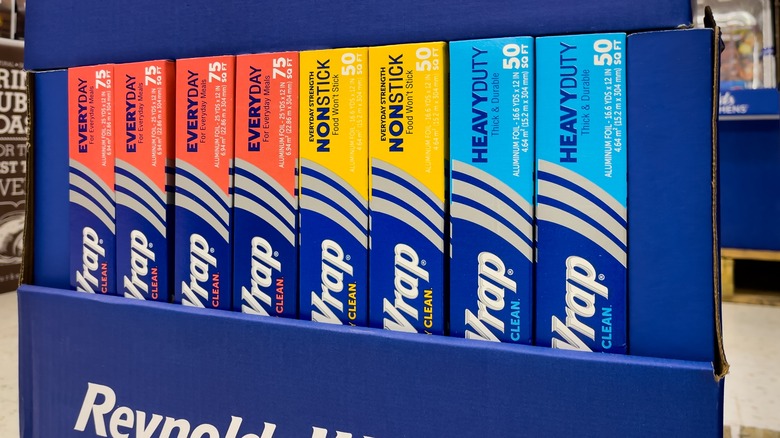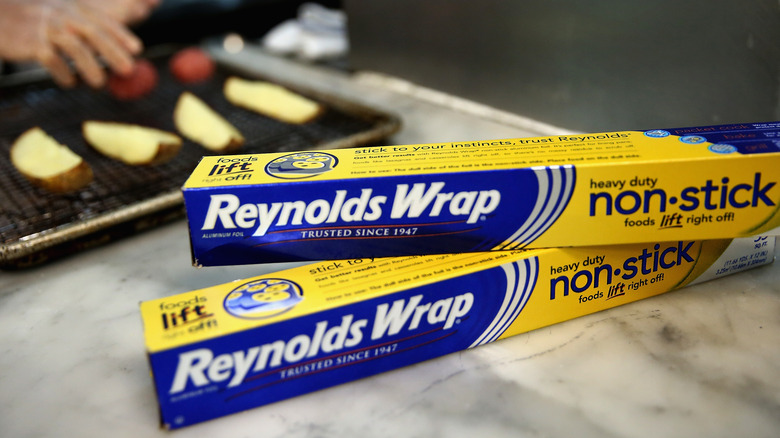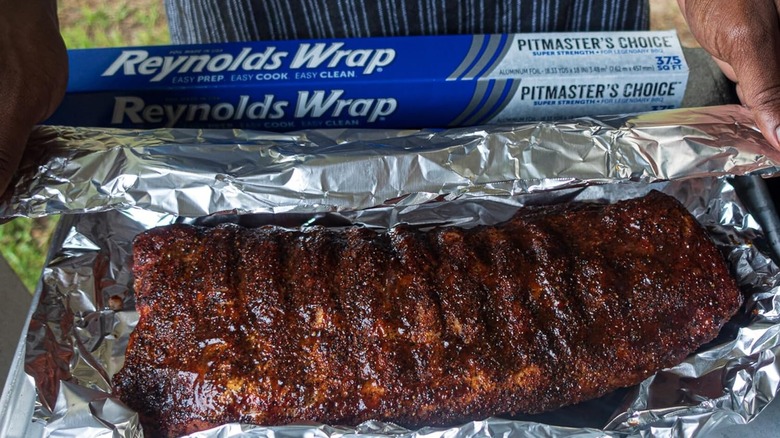The Different Types Of Reynolds Wrap Aluminum Foil Explained By The Color Of The Box
We may receive a commission on purchases made from links.
For some people, there's no need to spend a lot of time thinking about aluminum foil. You buy either the cheapest or the thickest and get on with your day. For the other 7.951 billion of us, Reynolds Wrap is now color-coded, so you can get the specific foil you want just as fast as those other two folks. Sometime around 2021, Reynolds Brands changed the accent color on their Heavy Duty foil packaging to blue rather than the old pink. That doesn't seem to have stuck — the company's website now shows the old pink color again — but the notion of associating particular colors with particular varieties of their aluminum foil took hold, and everything but the Heavy Duty seems to be color-coded these days.
Specialty foils make sense around the house. We've covered a lot of household uses for aluminum foil, from making grill-cleaning easy to keeping pests of all sorts away from your home. Why not have the choice of buying a different or upgraded version to better accomplish whatever you're trying to accomplish?
Reynolds Wrap's color code
The name of each foil variety is printed prominently on the color, so there's no need to memorize Reynolds' palette. But there's also nothing particularly hard about it, and the color choices make sense. The company's Everyday foil and foil sheets are still pink; this makes sense for a flagship product with this level of popularity since it might prove foolhardy to mess with the brand too much. This might also be why the Heavy Duty foil and foil sheets seem to be returning to pink instead of the blue that was marketed a few years ago. It's a popular variation on the core product, and it might not be a good idea to make consumers uncomfortable with or confused about the choice by switching up the packaging colors too aggressively.
Other foil lines stand out for the same reasons. Your eye might wonder why the foil you're picking up is in green packaging, and it turns out to be because green is the new color for their line of Recycled aluminum foil. Yellow represents their non-stick foil, while Reynolds Grill Foil is packaged in orange, and the relatively new Pitmaster's Choice foil is accented in silver.
Why all these varieties of foil
One could be forgiven for wondering why the world needs so many types of aluminum foil, and while part of the actual answer is doubtlessly driven by marketing strategies, the current offerings (and associated color scheme) make sense for foil users. The green Recycled foil is made from 100% recycled aluminum and has the same weight and strength as Everyday (pink) foil. The non-stick foil is a natural for food storage and probably many other uses, and Reynolds' yellow-labeled non-stick foil is food-safe and freezer-, oven-, and grill-safe as you'd expect. The orange Grill Foil also features a non-stick coating, is the same strength as Heavy Duty, and is wider — 18 inches, to cover the whole grill grate.
Pitmaster's Choice (silver) has been around under different names (Extra Heavy and Super Strength), and the name might make you think it overlaps with Grill Foil. But their 18-inch-wide foil is actually substantially thicker — almost 50% thicker, according to YouTuber @TheVirtualWeberBullet, who had it measured with a micrometer. This product could be a boon to those who use aluminum foil in the garage and garden. When we successfully attempted to use aluminum foil as a caulking gun replacement, the extra strength would have been great for our confidence in the process. The extra thickness might also be useful when doing tasks like using foil to remove stubborn rust from your outdoor furniture, though it's not clear how the non-stick coating would affect that chore.


